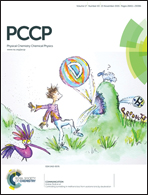The role of structural fluctuations and environmental noise in the electron/hole separation kinetics at organic polymer bulk-heterojunction interfaces
Abstract
We investigate the electronic dynamics of a model organic photovoltaic (OPV) system consisting of polyphenylene vinylene (PPV) oligomers and a [6,6]-phenyl C61-butyric acid methylester (PCBM) blend using a mixed molecular mechanics/quantum mechanics (MM/QM) approach. Using a heuristic model that connects energy gap fluctuations to the average electronic couplings and decoherence times, we provide an estimate of the state-to-state internal conversion rates within the manifold of the lowest few electronic excitations. We find that the lowest few excited states of a model interface are rapidly mixed by C![[double bond, length as m-dash]](https://www.rsc.org/images/entities/char_e001.gif) C bond fluctuations such that the system can sample both intermolecular charge-transfer and charge-separated electronic configurations on a time scale of 20 fs. Our simulations support an emerging picture of carrier generation in OPV systems in which interfacial electronic states can rapidly decay into charge-separated and current producing states via coupling to vibronic degrees of freedom.
C bond fluctuations such that the system can sample both intermolecular charge-transfer and charge-separated electronic configurations on a time scale of 20 fs. Our simulations support an emerging picture of carrier generation in OPV systems in which interfacial electronic states can rapidly decay into charge-separated and current producing states via coupling to vibronic degrees of freedom.


 Please wait while we load your content...
Please wait while we load your content...